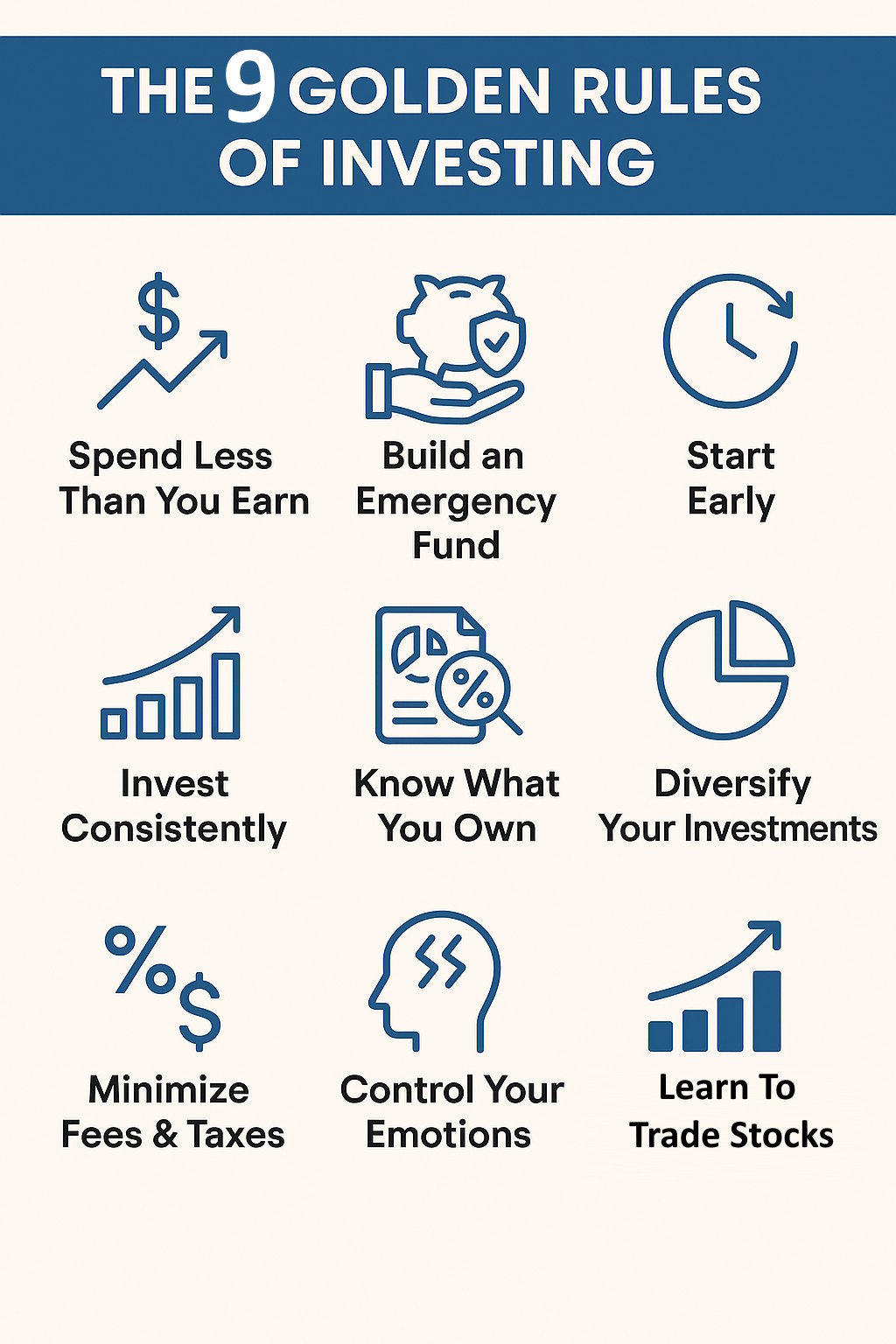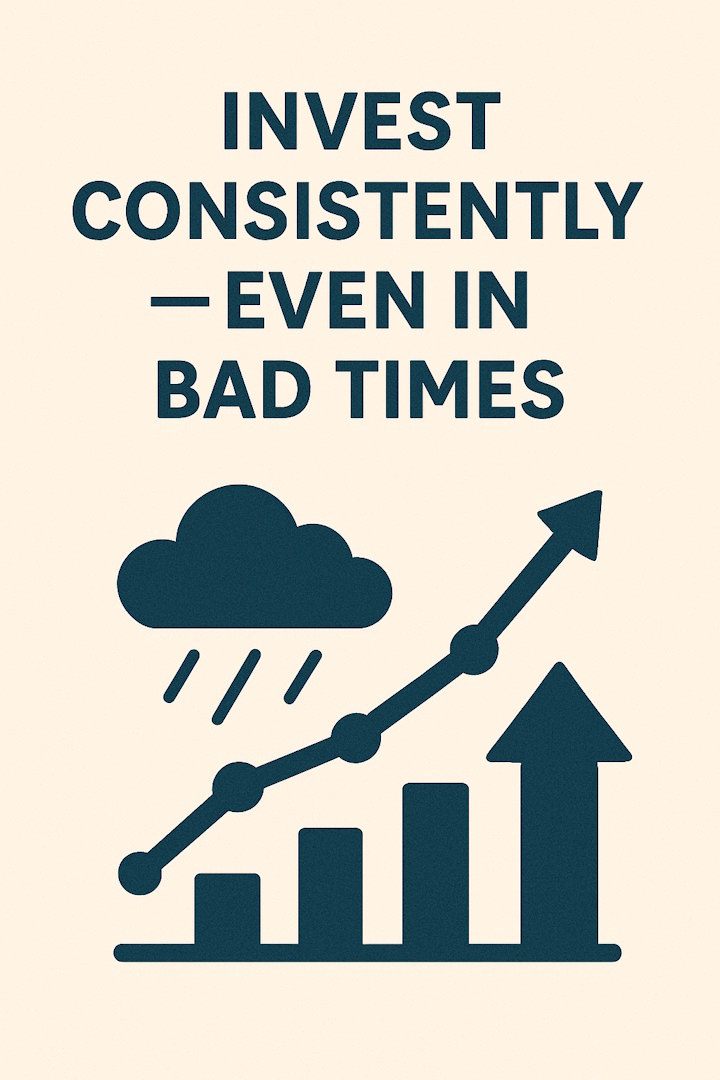Building long-term wealth through investing isn’t about chasing hot stocks or trying to time the market. It’s about following timeless, proven principles with discipline and patience. Whether you’re just getting started or seeking to refine your financial habits, these nine golden rules will help guide you on the road to lasting financial freedom.
🎯 Why Investing Rules Matter
Most new investors jump into the market with excitement but little direction. Unfortunately, many lose money or give up after a few missteps. Research shows that more than 90% of retail investors underperform the market, not because the market is rigged, but because they break fundamental investing rules.

Common errors include chasing trends, panic selling during downturns, overconcentration in a single stock, and failing to plan for emergencies.
Having a set of principles helps investors stay grounded. These rules serve as guardrails, keeping your investment strategy aligned with your financial goals, regardless of market volatility.
🧾 Rule 1: Spend Less Than You Earn and Invest the Rest

Your income doesn’t determine your wealth — your saving rate does. People who consistently spend less than they earn and invest the difference create financial freedom, regardless of their salary level.
Use practical budgeting methods like the 50/30/20 rule:
- 50% for essentials (housing, food, transportation)
- 30% for discretionary spending (dining out, hobbies)
- 20% for saving and investing
If 20% sounds too high right now, start with 5% or 10%, and increase it as your income grows. Automate your savings to remove the temptation to spend it.
Long-term wealth is built not from windfalls but from small, consistent financial habits.
💰 Rule 2: Create an Emergency Fund First

Before diving into investing, it’s essential to secure your financial foundation. That means having an emergency fund — a pool of easily accessible money to cover unexpected expenses like:
- Medical emergencies
- Job loss
- Car repairs or home maintenance
Without this buffer, you might be forced to sell investments at a loss during a downturn just to pay your bills.
A good rule of thumb is to save 3 to 6 months of essential living expenses. Store it in a high-yield savings account or money market fund — not in stocks or volatile assets.
This fund isn’t for investing — it’s for peace of mind. It buys you time and protects your long-term strategy from being derailed by short-term crises.
🥇 Rule 3: Start Early — Let Time Work for You

The sooner you start investing, the more time your money has to grow and accumulate interest. This is thanks to the power of compound interest, often referred to as the “eighth wonder of the world.” Compounding allows your investments to generate earnings, which are then reinvested to produce even more earnings, like a snowball rolling downhill.
Example: If you invest just $100/month starting at age 25 with a 7% average return, you’ll have over $120,000 by age 55. Wait until 35 to start? You’ll have only $57,000. That 10-year head start nearly doubles your results.
You don’t need a lot to begin. Start with what you can afford, and let time do the heavy lifting. Investing early gives you flexibility and reduces the pressure to chase high-risk returns later in life.
🧺 Rule 4: Diversify — Don’t Bet the Farm

Diversification is a strategy that involves spreading your investments across different asset classes (such as stocks, bonds, and real estate), sectors (including technology, healthcare, and utilities), and geographies (the U.S., Europe, and emerging markets).
Why? Because no one can predict which sector or region will perform best each year. Diversifying reduces the risk of catastrophic loss if one area underperforms.
For beginners, a simple way to diversify is through low-cost index funds or exchange-traded funds (ETFs). For example:
- An S&P 500 index fund gives exposure to 500 U.S. companies
- A global ETF spreads investments across multiple countries
Diversification helps you capture market growth while minimizing downside risk. It’s a foundational principle of smart investing.
Remember to consult a registered financial advisor before making any investment decisions.
📆 Rule 5: Invest Consistently — Even in Bad Times

Trying to time the market — waiting for the “perfect” moment to invest — often leads to missed opportunities. Instead, use dollar-cost averaging: invest a fixed amount at regular intervals, regardless of market conditions.
This approach removes emotion from investing and ensures you buy more shares when prices are low and fewer when prices are high. Over time, it evens out your cost and keeps you on track.
Fun fact: Missing the 10 best days in the market over a 20-year span can cut your returns in half.
Market dips are not a time to panic — they’re a chance to buy quality investments at a discount. Stick to your plan, automate your contributions, and trust the process.
📘 Rule 6: Understand What You Own (and Why You Own It)

One of the most overlooked rules by beginners is this: Only invest in what you understand. Investing blindly in trends, such as meme stocks or speculative cryptocurrencies, can lead to significant losses if you are unaware of the associated risks.
Before buying any investment, ask:
- What does this company/fund do?
- What are its earnings, growth prospects, or expenses?
- How does it fit into my portfolio?
Read the basics:
- ETF fact sheets (showing holdings, costs, and strategy)
- Company reports and financial summaries
- Analyst ratings and risk assessments
If you can’t explain your investment to a friend in 30 seconds, you may not understand it well enough to make an informed decision.
💸 Rule 7: Minimize Fees and Taxes

Fees and taxes are silent killers of long-term returns. A fund with a 1.5% expense ratio vs. a 0.05% index fund might seem similar, but over 30 years, the high-fee fund can cost you tens of thousands.
Utilize low-cost providers such as Vanguard, Fidelity, or Schwab. Pay attention to:
- Expense ratios (under 0.25% is ideal)
- Trading fees and commissions
- Account maintenance fees
Also, leverage tax-advantaged accounts:
- Roth IRA: pay taxes now, grow tax-free
- Traditional IRA/401(k): reduce current taxable income
Understand capital gains taxes and avoid excessive trading to minimize tax liabilities. Holding investments for the long term not only saves on taxes but also builds wealth more reliably.
😌 Rule 8: Keep Your Emotions in Check
Markets go up and down. It’s natural. But many investors panic when prices fall or get greedy when markets soar. Emotional reactions lead to poor decisions like:
- Selling low in a panic
- Buying high out of FOMO (fear of missing out)
Warren Buffett’s advice: “Be fearful when others are greedy, and greedy when others are fearful.
Discipline is the antidote. Create a written plan — your investment policy — and refer to it during turbulent times. Utilize automated investing platforms or robo-advisors to stay committed to your strategy.
Remember: Your mindset is just as important as your portfolio.
🧪 Rule 9: Only Trade with Money You Can Afford to Lose

Once you’ve mastered the first eight rules — you’ve built your savings, diversified your portfolio, and established consistent good habits — then and only then should you consider active trading.
Stock trading can be rewarding, but it comes with high risks. Use only the money you can afford to lose, not your retirement savings or emergency fund. Keep your core investments safe and stable.
If you enjoy market speculation or want to test out strategies, create a small, separate trading account. Limit your exposure and always track your performance with a long-term mindset.
Trading should never replace a sound investment plan. It should be approached with caution, education, and strict boundaries.
If you want to start trading, get the best start with our Liberated Stock Trader Pro Course.
✅ Summary Checklist: The 9 Golden Rules
- Spend Less Than You Earn — Your savings rate matters most
- Build an Emergency Fund — Secure your foundation first
- Start Early — Compound interest needs time
- Diversify Your Investments — Spread out your risk
- Invest Consistently — Stick with your plan through ups and downs
- Know What You Own — Understand your investments
- Minimize Fees & Taxes — Keep more of your returns
- Control Your Emotions — Stay calm and disciplined
- Trade Only with Extra Money — Protect your future first
🔚 Conclusion: Wealth Is Built with Discipline, Not Genius
Successful investing isn’t flashy. It’s not about picking the next Tesla or getting rich overnight. It’s about having a plan, sticking to it, and letting time do the heavy lifting.
These nine rules provide a framework for making informed, steady decisions. If you follow them, you won’t just be investing—you’ll be building a secure and prosperous future.
